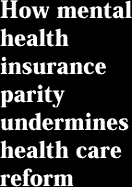
|



Revelations of mental
health insurance
fraud over the past
year alone, including
$299 million fleeced from
Medicare, demand
a different kind
of reform.
by Gail Armstong & Thomas G. Whittle


artha Tapia passed unnoticed by a psychiatric technician as she was escorted through a Florida psychiatric ward on October 12, 1998. She had been desperate for help when Cecilia, her 20-year-old with the mental capacity of a child, was admitted a week earlier. Visitation had been severely limited and for the past day, Martha had been refused contact with her daughter, who was said to be in the “quiet room.” Martha could only hope for the best.
Cecilia greeted her with an affectionate hug, but became distracted by the male psychiatric technician in the hallway. To Martha’s chagrin, Cecilia ran to the man and hit him in the face. The technician, standing 6’ 4”, grabbed Cecilia by her shoulders, and with the force of his 300 pounds, slammed his knee into her groin. The impact lifted her off the floor, knocking her backwards; she fell on a counter and landed on the floor.
As Cecilia lay on the floor in pain and shock, the man drove one knee down onto her hand, pinning it to the floor. He shoved his other knee into her stomach, while pulling her hair so as to twist her head. Cecilia was screaming in pain, but a male psychiatric nurse joined in on her other side, twisting her free arm and shoving his knees into her chest.
When the technician heard Martha yelling in outrage at the brutality, he screamed at her to get out. Instead, Martha demanded answers. She was to learn that Cecilia’s stay at the institution had been a nightmare from which there was no escape. Emboldened by her mother’s presence, Cecilia had attempted to retaliate against one of her tormentors—for having been strapped all night to a bed soiled with another’s feces, heavily drugged and physically abused. That restraint, one of a series she suffered, was punishment for having asked for a second bag of potato chips at snack time.
It took many hours, but Martha and her husband secured their daughter’s release. The evidence of Cecilia’s experience was apparent: red welts marked where leather straps had dug into her wrists; medical examination and photographs documented bruises and lesions on her body. Past surgery on her hip was aggravated and she limps chronically. She found it hard to stand, sit or walk, and lost control of her bladder.
And the family’s insurance was billed for it.
Cecilia emerged from her “treatment” broken and abused, with mental scars that will last a lifetime.
But at least she came out alive.
Tragic and avoidable deaths from psychiatric restraints occur regularly nationwide. Investigative reports published by The Hartford Courant over 1998 and early 1999 documented 151 restraint deaths in institutions across the U.S. since 1988. Further reports of deaths abound. A research specialist at the Harvard Center for Risk Analysis, commissioned by the Courant, estimated that the actual number of restraint-related deaths—since many go unreported to authorities—is between 50 and 100 each year.
According to industry observers, those figures mean that hundreds or perhaps thousands like Cecilia are harmed but live through the ordeal.
During the early and mid-1990s, close to 1,000 surviving ex-patients of one of the nation’s then largest chains of psychiatric facilities—National Medical Enterprises (NME)—filed lawsuits charging that various hospitals and psychiatrists illegally imprisoned them in order to cash in on their insurance monies. Many of the patients were children or teen-agers when admitted and were subjected to abuse, including frequent use of restraints—sometimes for weeks at a time. Nearly 700 of those civil suits have since been settled for $100 million.
The proliferation and abuse of restraints could be more intimately linked to insurance fraud than previously thought. Recent evidence suggests that restraint use may be claimed under “intensive care” for a higher rate of reimbursement.
Widespread Fraud & Abuse
While deaths from psychiatric restraints are spurring U.S. Senate hearings and House legislation in 1999, they are far from the only evils that lie in the wake of psychiatric fraud.
A federal criminal investigation into NME found that tens of thousands of patients around the country were given unnecessary treatment by psychiatrists in order to illegally collect insurance money. NME paid out $379 million to settle the criminal charges in 1996, and got out of the psychiatric business.
NME’s well-publicized catastrophe with psychiatric fraud, however, did not deter the practice elsewhere.
Medicare announced in September 1998 that it was expelling 80 community mental health centers after federal investigators found that the program to provide psychiatric services to the elderly was riddled with fraud. According to a report by the U.S. Department of Health and Human Services, during 1997 alone, 90 percent of Medicare’s payments to community mental health centers—$229 million—went to psychiatrists’ “unallowable and questionable services.”
All told, psychiatric fraud has cost taxpayers a conservatively estimated $20 billion in the United States alone, and as much as $40 billion. The cost in terms of human lives and misery is incalculable.
Fatter Funds
Despite the overwhelming evidence of psychiatric fraud and concomitant abuse, federal and state legislators are relentlessly bombarded with demands to mandate fatter insurance funds for psychiatry under the banner of “mental health parity.” To not provide the same benefits for mental illness as exist for physical illness, the parity argument goes, is to discriminate against those who have mental disorders.
Patients’ advocates and psychiatric industry watchdogs agree that discrimination is a serious problem for those labeled as mentally ill—but it is perpetrated by the psychiatrists themselves. Discrimination is manifest far more often in the denial of fundamental rights and competent medical treatment to psychiatric patients than in any perceived disparity of insurance benefits. And the results, including deaths, are far more serious.
Further, insurance industry experts and economists state that mandated health insurance benefits (of all types) are a significant cause for increasing lack of health insurance coverage, and are already pricing up to 10.2 million Americans out of the health insurance market. (See “Pricing Americans Out”)
The “Grass Roots” Lobby
The front-line entity pushing mental health insurance parity is the National Alliance for the Mentally Ill (NAMI). On the surface, NAMI is a support group concerned with eradicating the social stigma attached to those suffering from severe mental disorders. The group is found in the lead of an ostensibly “grass roots” media and legislative campaign for parity and against discrimination.
The campaign steers clear of the well-founded concerns of patients’ advocates and industry observers that more access to insurance funds will mean yet more fraud and abuse, not to mention an increasing burden on employers and consumers.
From an investigation of NAMI’s agenda, one might conclude that it has little room to address such concerns, nor can it afford to. The “grass roots” movement has an organized headquarters and chapters in each state, professional PR services, streams of pre-packaged, just-add-water media and lobbying instructions for members—and campaign sponsorship from multi-billion dollar pharmaceutical firms whose drugs dominate the psychiatric industry for “treatment” of mental disorders.
And where the psychiatric lobby has failed to convince government to subsidize psychiatry outright, NAMI campaign literature and statements make it apparent that they developed a strategy of circumvention.
Scientific Deficiency
To achieve insurance parity, the psychiatric industry has to position mental illness on a scientific par with physical illness—which opens the door to equal benefits across the boards.
Psychiatrists, however, have often been balked in government funding efforts because their claims about mental illnesses and cures simply lack scientific merit. The medical-scientific community widely acknowledges the deficiency, as do some in the psychiatric community. Even the former acting director of the National Institute for Mental Health (NIMH), Rex Cowdry, stated candidly of “mental illness” before U.S. House of Representatives Appropriations Subcommittee hearings, “We do not know the causes. We don’t have methods of ‘curing’ these illnesses yet.”
Claims about the efficacy of psychiatric drugs prescribed to “cure” the “chemical imbalances” in people’s brains also lack proof. In one study in 1998, researchers Irving Kirsch of the University of Connecticut and Guy Sapirstein of Westwood Lodge Hospital, Massachusetts, analyzed 19 prior studies on antidepressants and sedatives involving 2,318 patients. Their findings ruled out that any chemical balance in the brain is restored through the drugs.
“We do not really know anything about this business of the brain. We are just at the borderline of how it even works chemically,” says Dr. Walter Afield, nationally eminent psychiatrist and examiner for the American Board of Psychiatry, who currently serves as Medical Director of the Neuropsychiatric Institute in Tampa, Florida. “Yet a doctor gives a drug to someone, and when it has a side effect, balances it with this other drug, and so on, and it gets to be so much hocus-pocus.”
Parity campaign organizers however seem to have taken seriously the idea that repeating a lie will make it “true.” They have deployed their lay troops to repeat stock slogans, phrases and definitions to turn mental illness into physical illness by general—albeit misinformed—consensus.

Cashing In continued...
|

|
















